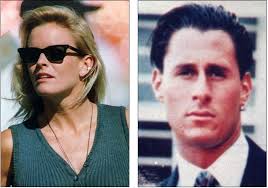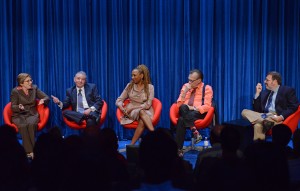 Where were you on the night of June 12, 1994 – the horrible night when Nicole Brown Simpson and Ronald Goldman were knifed to death outside her Brentwood home? If you don’t remember exactly, you’ll surely recall where you were during the infamous slow-motion white Bronco chase when O.J. Simpson was on the run after being charged with their murders.
Where were you on the night of June 12, 1994 – the horrible night when Nicole Brown Simpson and Ronald Goldman were knifed to death outside her Brentwood home? If you don’t remember exactly, you’ll surely recall where you were during the infamous slow-motion white Bronco chase when O.J. Simpson was on the run after being charged with their murders.
Twenty years later, the memories came flooding back as the Paley Center for Media and Investigation Discovery gathered a panel of experts associated with the O.J. trial to examine the media’s role in this transformative event in the racial and social history of our nation.
Before the discussion, a condensed, 45-minute version of Investigation Discovery’s (ID) new documentary “O.J.: Trail of the Century” from Emmy-winning filmmaker Nicole Rittenmeyer was screened.
It showed key moments from the murder scene investigation, the preliminary hearing which bound O.J. over for trial and the year-long trial itself, including the notorious incident where Simpson tried on a pair of bloody leather gloves and then his attorney, Johnnie Cochran telling the jury, “If it doesn’t fit, you must acquit.” And in the end, they did – after just four hours of deliberation– setting off social and legal reverberations that riveted a worldwide audience, and continue to this day.
Participating in the panel moderated by Variety’s TV critic Brian Lowry were Howard Weitzman, Simpson’s first criminal defense attorney during the trial, Kimberlé W. Crenshaw, UCLA law professor and author of “Words that Wound: Critical Race Theory, Assaultive Speech and the First Amendment,” talk show host Larry King and Laurie Levenson, legal correspondent for CBS & NPR and a professor of law at Loyola Law School.
The first topic at hand, cameras in the courtroom.
Weitzman was the one panelist who opposes them, except when it comes to the US Supreme Court–where he would like to see the court’s activities televised.
“It changes the landscape through which jurors view criminal proceedings,” said Weitzman, who acknowledged that he was friends with Simpson but wouldn’t specify why he recused himself from the defense.
“The camera is just a messenger,” said Levenson. “These trials are supposed to be public. But the behavior changes, and the judge has to keep control.”
The discussion quickly cut to the heart of the matter, the lies that were exposed during the proceedings that provided more than a reasonable doubt about Simpson’s guilt.
“Catching people in a lie changes everything. That’s what happened here,” Weitzman said, calling out LAPD detectives Mark Fuhrman and Philip Vannatter.
“The prosecution was overconfident, and served up the evidence on the dirty platter,” Crenshaw said. “They weren’t ready.”
Lowry quickly brought the conversation around to how celebrity affects the wheels of justice and noted how the trial came at the dawn of the 24-hour news cycle and well before the advent of social media–and even widespread use of the Internet.
And then there was the hot-button issue of race and how it played out during the drama.
“White people liked O.J. To blacks, he represented a fantasy of wealth and fame that can be achieved,” Crenshaw said. “Most black people don’t have the money to expose [what were] LAPD’s often typical practices. He was a symbol. He had no reason to claim racism, but he played the race card.”
“He was a leader on his teams, he never got into fights with referees, and the Hertz people loved him when he did the commercials. How do you explain the enigma,” King posited. “Peter Falk told me that the O.J. case was a 10-minute ‘Columbo,’” King continued. “He was the biggest person in history to be charged with murder. World War IV could’ve broken out and we would’ve still stayed with the coverage of Simpson. ”
“Nobody saw O.J. testify,” said Levenson. “But they had seen the commercials and the movies. In the civil case, you saw how he got angry during instances when he was on the stand.”
“It’s about domestic violence. A slow simmering series of violent occurrences,” Crenshaw said, while Levenson noted the prosecution couldn’t introduce the previous instances of abuse that had occurred between O.J. and Nicole and did not present a cohesive case that she was the victim of domestic violence.
There was also discussion about Dist. Atty. Gil Garcetti’s decision to hold the trial in downtown Los Angeles rather than in the Santa Monica jurisdiction where the murders had taken place, code for having more white jurors.
“The jury should have risen above the prosecution’s mistakes find Simpson guilty, or at least come back as a hung jury,” Crenshaw said.
–Hillary Atkin


